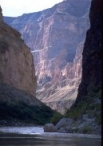|
|
NEWS AND VIEWS
|
 |
|
I
had an article published in Kansas English called "Writing-to-Learn
in the Transition from High School to College."
|
|
I was
in Connecticut this week for 4 poetry readings and my niece's wedding.
On another note, I recently won the poetry manuscript competition
at Steel Toe Books, and they will be publishing my new book about
my parents, Dreaming in America, in Spring 2007.
|
|
I am thankful every day to be a part of this department where our faithful correspondence and friendship adds a precious facet to living, builds a bridge between centuries that we can cross barefoot, laughing. I imagine it sounds tame, but I have become interested in realizing that long before we were humans, long before we were even animals, we living creatures were plants; and we have internalized their rhythms and aspects. We turn to the light, and when we’re at our best, we turn phototropically, like a sunflower, without thought or strategy. We may not manufacture sugar from sunlight like our green cousins, but that is only because we have moved on to manufacture proteins and enzymes and hormones and poems. After a “stimulating and challenging” spring semester (Atwood “Happy Endings”), I transitioned into three summer carpentry jobs: a beautiful kitchen with countertops of quartz, an Andersen window and door replacement project for a writer’s studio, and an elegant master bathroom, where natural light pours in to what once was a dungeon. Upon completion of these projects, Karen and I boarded a train in downtown Chicago on July 15 and headed out to Waterton-Glacier International Peace Park for three weeks to visit her daughter Jamie who is an interpretive park ranger there. We hiked one hundred and twenty miles of trails. We saw bears more days than not, brown and black, as well as moose, marmots, big horned sheep, and mountain goats. We paddled with a loon and saw eagles, both Golden and Bald. During the initial hours of a forest fire at St. Mary’s which eventually grew to engulf twenty-eight thousand acres, six smoke jumpers from Missoula, Montana parachuted into the blaze that had been ignited by Boy Scouts attempting to roast a Columbian Ground Squirrel, and one of the chutes was attacked by a pair of Golden Eagles. Know the feeling? We
backpacked fourteen miles to the Granite Park Chalet, where a great
kitchen and comfortable beds are available—you just bring
yourself and your food and your camera. There are a few large wooden
tables in the common area downstairs, a room that is floored with
grey slabs of petrified ripples: the entire region was once an ocean
bed that was thrust upward by the collision of tectonic plates,
forming a high plateau that was subsequently carved into peaks and
cirques by the many glaciers that remain today. Again, a metaphor
of our formative years (and here’s a news flash: do they ever
stop being formative?). Speaking of which, I read a book on global warming while sitting on the Grinnell Glacier, not far from the Al Gore Rock. Have you seen An Inconvenient Truth? We
visited Waterton, Canada three times. After a glorious fourteen
mile hike called the Carthew-Alderson Trail, we swam in the glacial
waters of the big lake and I fell in love—with Kokanee Glacier
Beer. Later, on Canadian TV the same day Fidel handed power to Raul,
there was a long segment on icebreakers trying to establish the
new northern boundary based on a revised map of the continental
shelf. These ships were pushing through soft ice and slush that
have been impassable for many thousands of years. Welcome back, everyone. Keith P. S. I sense an idealism in my students I have not felt for years. I neglected to mention that my son Huck was married in Austin on August twelfth, so we got home by train, I mowed the yard, and we flew to Texas. As for the train ride to Glacier, too beautiful for words.
|
|
Having received tenure, I anticipate resting comfortably on my laurels for the rest of my career. "No more research, no new course preps, and for God's sake--no service!" Ummm, I guess that won't do, will it? The real scoop, for what it's worth: Early
this summer I completed a review essay, "Daughters of the
Tenth Muse: New Histories of Women and Writing in Early America,"
which will appear in Early American Literature in December.
My book Women and Authorship in Revolutionary America
will finally be between covers by the end of the year. Delightfully,
it was accepted to the same series as Julie Campbell's Literary
Circles And Gender in Early Modern Europe: A Cross-cultural Approach
(Ashgate's Women and Gender in the Early Modern World series).
More recently, I've been working on several interrelated projects
focusing on the connections between gender, race, and writing
style in 18th-century Anglo-American literature.
|
|
In late May, I attended the Thomas Wolfe Society meeting in Chapel Hill, N.C. It was a busy two days as I moderated a plenary session, met with the staff of the Thomas Wolfe Review, attended Executive Board meetings, listened to every paper (scouting for articles), and talked to lots of people. At the banquet, I received an award from the Society: the "Paul and Zelda Gitlin Prize" for the best scholarly article on Wolfe published in 2005. The award was for my essay "Sitting Where van Gogh Sat: Exile and the Narrative Vocation in Thomas Wolfe's Of Time and the River."
At the end of June, I traveled to British Columbia, where we participated
in the International Lawrence Durrell Society conference at the
University of Victoria. In addition to listening to interesting
papers and attending meetings, I moderated two plenary sessions,
took part in a panel on "Teaching Durrell," and gave
a paper titled "'Always Friday the Thirteenth': The Knights
Templar and the Instability of History in Lawrence Durrell’s
The Avignon Quintet."
|
